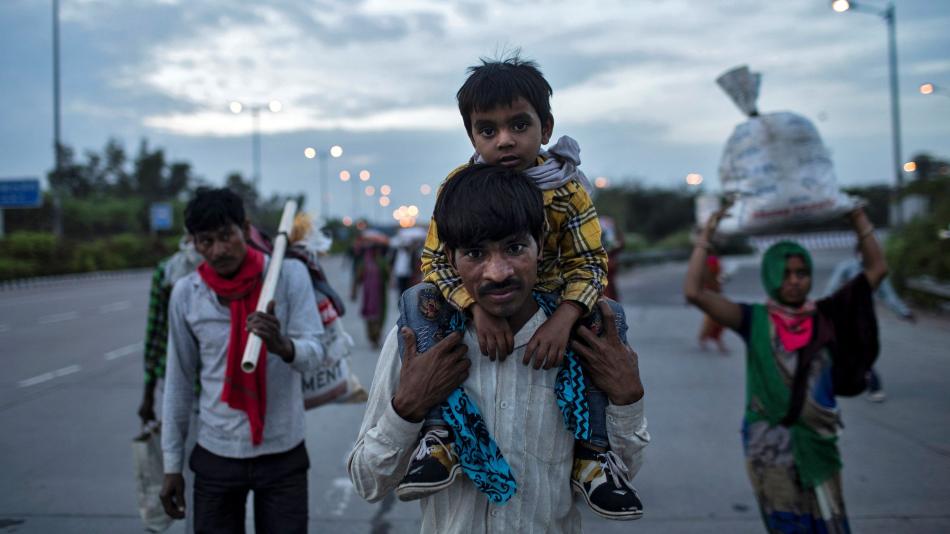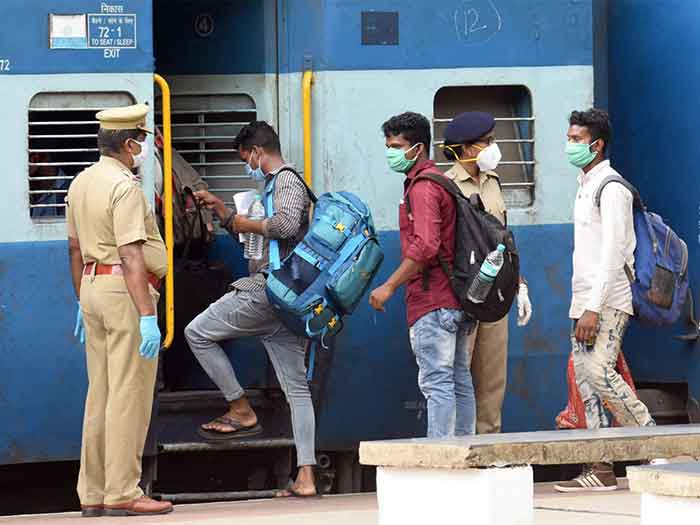
India’s migrant labor plight and crisis came to the fore, in most tragic forms, during recent period thanks to the Corona virus disease. We should not forget that the problem was always there, and Covid-19 exposed the callousness of the system as never before. Labor wanted to back home at any cost, walking hundreds of kilometers, with kith and kin, in hot sun.
Now that lockdown is being lifted, employers want the labor back. Bitter experiences, memories, continued problems and scare of the pandemic, make things difficult both for the toiling millions and the employers, small and big. The economy is in deep depression, problems haunting both the labor and the employers. A search for solution is the need of the hour.
The PM Sri Modi recently visited Rajasthan, and on June 20, launched a Garib Kalyan Rozgar Abiyan (GKRA) with an outlay of Rs. 50,000 crore ostensibly to help the migrant labor who returned home. It is nothing but a rehashed and renamed MGNREGS , the Rural Employment Guarantee scheme, which has been there for more than a decade now, and which he had despised when he assumed power as PM in the NDA-1.
Lakhs of crores of rupees were reportedly spent on the scheme over the years, by UPA and later NDA. The recent Covid-19 crisis exposed the fact that the scheme did not help to basically solve the problem of rural unemployment nor mitigated painful migration of rural labor.
MGNREGS remained more as a program of doles, as part of vote-bank politics, perhaps as originally conceived and implemented, than as a meaningful program of employment creation. Though it admittedly enabled, many corrupt contractors, touts, officers and politicians, to swindle billions of rupees. No tangible and lasting assets were created despite billions being spent on it, and we lost more than a decade.
Some ideas are offered here through this article towards a solution of the problem. The discussion confines itself to the uneducated, poor migrants and not the highly qualified.
There has been a blame game about migrant labor between the parties ruling in the states and the Centre. Some have put the onus of these migrant labor’s maintenance and transport on the state and some on central govt, railways etc. Even courts have come into picture – Supreme Court , even if belatedly, ruled that in the next two weeks migrant labor transport should be completed.
The scale and volume of people’s movement is unprecedented and not seen in the Indian history or even in the world history. The only exception was at the time of Indian partition in 1947 in which even the migrants were vengefully killed on the basis of religion, in both countries – India and Pakistan. Fortunately, massacre is absent presently. It is different to the extent that the Govts, railways, philanthropists tried to help the migrant labour to a limited level with drinking water, food and transport, partly subsidized. But for a few incidents and accidents, it somehow passed off.
Now it has been recognized and well established that ‘migration is a survival strategy’. Presently, India has nearly the highest number of educated, qualified youth in the world. Take any developed country like USA, Canada, Australia, European Nations, even OPEC countries – Indian migrants are in sizeable numbers.
Budgets of Kerala are well supplemented or financed by transfers of money from NRIs, the repatriates. Being the highest literate state in India, Kerala teachers, nurses and the like can be seen in most of the Indian states, in Gulf countries and other nations. But, these migrants are not a problem to the host society or to themselves.
But, the same migration to Gulf is not so from the state of Telangana. The poor, illiterate gullible migrants from Telangana, and from AP to a lesser degree, to Gulf countries are quite often the sufferers. They are exploited by the agents demanding lakhs of rupees, leaving them often as illegal immigrants. At the destination the women are exploited physically also, by the sheiks by confiscating their documents. Most of the times, they have to be rescued by the authorities in a miserable condition. This is nothing but a sheer failure of the state govt. and its agencies. The Govt must come down heavily on such unscrupulous agents and their methods.
The intra-state migrations are not causing much problem as the conditions are not totally unfamiliar to the immigrants and also the distances from home to the place of migration are not very high.
Seasonal migrations are also substantial within the country. Notable among them are sugar cane cutters in Maharashtra who are about 6.5.lakh – they are one of the most exploited lot. They live in miserable conditions. Same is the fate of paddy harvesting seasonal migrants to Bardhaman district in Bengal. Migration to Assam Tea plantations, to Odisha mining sites, migration to Punjab and Haryana during harvesting season from UP, Bihar are other notable examples. Fishermen of AP travel far and wide. About 50,000 Kerala women migrate to work in fish processing industry in Maharashtra. The out-migrating states are notably UP, MP, Bihar, Bengal, Odisha and even Telangana. The popular destinations for them are Maharashtra, Kerala, Gujarat, Punjab, Haryana, and Greater Delhi. In the South between Kerala and Tamilnadu sizable migrations are seen.
In India it is said that every fourth person is a migrant. Most of them are landless or poor peasantry and farm labor, more so rain-fed areas, who don’t have (enough) employment for many months every year. Of these the poor, illiterate migrants within the country are the worst sufferers. They are treated mostly as second class citizens.
These migrant labor mostly live in sheds, jhopdis, in very unhygienic, uncertain and undignified conditions. Even the places of work are no better.
The women do not get any maternity leave like their counterparts in organized sector. Immediately after delivery, they return to work. The infants are not cared for. No immunization schedule for them. No nourishing diet to the children and mothers. No proper schooling for children. The old parents are not cared for either at the place of work or even back at home.
They do not get entitlements of public distribution system (PDS), subsidized provisions. They do not get health care benefits. In case of ill health or accidents, they are at the mercy of the contractors, without proper and statutory compensation, ESI facilities are not available to them. They do not get any rights like other citizens of the state. Thus they do not have any civic rights like any other citizen of the country.
Coming to the epidemic conditions like the present Covid-19, they are the worst sufferers obviously. Mostly they belong to the scheduled tribes, castes and other so called lower classes of the society. The mega cities like Mumbai have the highest number of such hapless people.
For the above group, migration is often not a strategy for survival but only an adhoc movement, ruthless exploitation, suffering and ruination awaiting them. Should we allow them to continue to suffer like that when the country- not the people- is progressing in GDP growth, and as a notable world power!
Hitherto the model has been to invite investors and entrepreneurs to start industry, provide them with incentives like subsidized land, subsidized power, tax concession or tax holidays etc. Then he would gather other factors of production like capital, labour, raw material, other resources like water, power etc.mostly at public expense.
Often we hear complaints from employers, big and small, of shortage of suitable labor, both in quantity and quality. This is the situation at a time when crores of people, more so of toiling classes, are unemployed or under-employed.
Why not we start, for a change, from the other end: Estimate the manpower resources of the area, say a district, and plan for their sustained employment.
The proposed industry has to provide meaningful employment to the available man-power, particularly to the unskilled. Engineers, highly skilled managers – whose requirement is not in large numbers can migrate. Some skill-development programs were launched by the Centre, whose effect is not tangible.
This should avoid out-migration of the poor, illiterate in search of employment, livelihood. The proposed industry need not remain so forever. Over a period, the skills of workmen are to be upgraded with suitable training and education, dove-tailed to meet the needs of employers.
The manufacturing process can thus be upgraded, the productivity thus going up. This helps to avoid or minimize migration of the gullible, poor, illiterate masses in search of survival over long distances, and suffer there for all their needs. Can we try this model?
To begin with, with such training of labor in villages, value addition of agricultural products can be enabled, pushing up productivity. Thus some of the corporate house projects, Fast Moving Consumer Goods (FMCG) industry etc, that are dependent on agri products can be shifted and dispersed over villages nearer to the fields and points of production employing our unfortunate brethren.
The experiences of China’s township and village enterprises TVEs, employing crores of labor, that have a major share of China’s employment, GDP and exports, are there to learn from. They helped to reduce poverty, enhance employment of rural labor. Wikipedia gives this information, useful though old:
TVE employment grew from 28 million in 1978 to a peak of 135 million in 1996. Likewise, production of TVEs increased to 1.8 trillion yuan in 1992 from 49 billion yuan in 1978. More than half of TVE production in the 1980s occurred in Guangdong, Fujian, Zhejiang, Jiangsu, and Shandong provinces, all of which border the Pacific Ocean.[5] In Jiangsu and Shandong TVEs employed some 30 percent of the rural workforce. Many of these firms were “collectively owned”.
That cuts down costs, social and economic, employs labor locally, and goods will be more competitive. That helps to avoid congestion and multi-sided pollution, and the urban slums can be minimized. All this will benefit the Indian society and economy.
See also by the same author :
Covid-19 In Dharavi : Let Crisis Be Turned Into a Solution
Published on May 8, 2020
https://countercurrents.org/2020/05/covid-19-in-dharavi-let-crisis-be-turned-into-a-solution/
(Srirama. M, now still socially active at age 75, is basically an electrical engineer, who worked in coal mine industry of Singareni Collieries of Telangana. He worked from the ground level as an Engineer and Manager , and retired as Chief General Manager. He worked , in all four districts where mining was spread over, with decades of experience, in managing one lakh strong man-power, including their housing colonies. He himself lives in a frugal way, in an old house, in a small town.)
SIGN UP FOR COUNTERCURRENTS DAILY NEWSLETTER














































